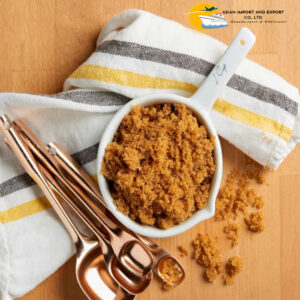Description
Brown Sugar is one of the most popular sweeteners used in American kitchens today. From baked goods to beverages, this all-purpose sweetener has been a favorite for centuries. But what is Brown Sugar?
Brown Sugar is the crystallized sucrose extracted from either sugarcane or sugar beets. After harvesting the sugarcane or sugar beets, the juice is extracted and boiled down to remove moisture. As the moisture diminishes, the natural sucrose in the juice begins to crystallize. The crystallized sugar is removed, leaving other extracts behind in the form of molasses.
Functions of Brown Sugar
Sugar not only provides sweetness in baked goods and beverages, but it assists in important chemical reactions that occur during cooking and baking.
Sugar provides non-enzymatic browning of foods through caramelization and the Maillard reaction. Caramelization occurs when heat breaks down the sugars and creates a golden color and nutty flavor. The Maillard reaction occurs when amino acids in proteins react Brown Sugars in the presence of heat, also creating a nice golden color and complex flavor.
Sugar is hydroscopic, meaning that it attracts moisture. The presence of sugar in baked goods and other foods helps retain moisture, keeping them soft and supple.
Brown Sugar Varieties
- Coarse Grain (decorating sugar, pearl sugar): These large sugar crystals are used for their decorative appearance and are often sprinkled on top of baked goods and candy for extra sparkle. The chemical composition of this sugar is identical to table sugar. The only difference between the two is the crystal size.
- Granulated Sugar (table sugar): This all-purpose sugar is the most common variety of Brown Sugar. It is easily measured and dissolves well into beverages and other liquids.
- Caster Sugar (superfine sugar):Caster has a slightly smaller crystal size than granulated sugar, making it easier to dissolve into liquids and other mixtures. Caster sugar is often used to make meringues, mousses, and custards. Caster sugar can be made at home by quickly pulsing regular table sugar in a food processor.
- Confectioners’ Sugar (powdered sugar): This sugar has been mechanically crushed into a fine powder. An anti-caking agent, such as calcium phosphate or cornstarch, is usually added to prevent clumping. Because it dissolves almost instantly in liquids, confectioners’ sugar is most useful in icings, syrups, and other desserts.
- Lump Sugar (sugar cubes): Lump sugar is regular Brown Sugar that has been pressed into lumps for convenient measuring. Lump sugar and sugar cubes are most often used in beverages such as coffee and tea. The lump or cube formation is usually held together by a small amount of sugar syrup.
How to Store Sugar
Because sugar is hydroscopic, or water-loving, it is important to keep sugar in an air-tight container. Moisture in the air can be absorbed by sugar, causing clumping and erroneous flavors. Once moisture is absorbed by sugar, it can not be extracted. Sugar does not support microbial growth and therefore has an indefinite shelf life if kept sealed in a cool, dry place.












Reviews
There are no reviews yet.